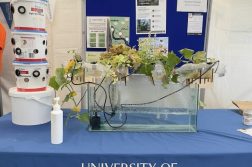While the world is fighting to slow down the COVID-19 pandemic, different Agencies have detected a cloud of radioactive material over Scandinavia. No country has come forward to take responsibility for this leak yet.
Early in July, authorities in Helsinki affirmed they spotted an increase in radiation levels in northern Europe. Dutch officials believe this intensification of radiating particles might have originated from a malfunctioning nuclear plant situated south-west from Scandinavia. Damages of the fuel element of an atomic reactor could be the source of the radioactive cloud circulating over Europe.
The Swedish Radiation Safety Authority tweeted on the 23rd of June: “Very low levels of the radioactive substances caesium-134, caesium-137, cobalt-60 and ruthenium-103 were measured”. Although the levels detected seem to pose no danger to people and the environment, similar observations were made in Finland and Norway, suggesting the radioactive cloud is larger than expected. Lassina Zerbo, the Executive Secretary of the Comprehensive Nuclear-Test-Ban Treaty Organisation, shared on Twitter a map of the area affected by the anomaly, pointing out a potential connection to a malfunction of a nuclear plant.
22 /23 June 2020, RN #IMS station SEP63 #Sweden🇸🇪 detected 3isotopes; Cs-134, Cs-137 & Ru-103 associated w/Nuclear fission @ higher[ ] than usual levels (but not harmful for human health). It shows the possible source region in the 72h preceding detection in orange on the map. pic.twitter.com/ZeGsJa21TN
— Lassina Zerbo (@SinaZerbo) June 26, 2020
Researchers at the Dutch National Institute for Public Health and the Environment (RIVM) studied the phenomenon and concluded this leakage could be traced back to man-made facilities. The particles observed in the cloud are artificial, thus eliminating a natural upsurge of radioactivity in the atmosphere. The Institute went further with their explanation, affirming the cloud may have originated from power plants in Western Russia, stating that they still cannot pinpoint a specific country of origin.
The Russian News Agency TASS reported no malfunctions detected in the two power plants in north-western Russia. The Leningrad NPP and the Kola NPP seem to be functioning as normal, stated a spokesperson for Rosenergoatom Concern (part of the Rosatom state nuclear energy corporation). Even though the power plants do not appear to be linked to the current spike in radiations, Russian facilities are not new to unexpected leakages.
Dutch officials have drawn parallels between the accident in June 2020 and a similar one dating back to 2017. In October 2017, scientists detected levels of ruthenium-106 a thousand times higher than normal. Russian authorities denied responsibility for what seemed to be an accidental release of the element. But a recent paper from the Institut de radioprotection et de sûreté nucléaire (IRSN) in France suggests otherwise. Data collected by the team of 70 scientists indicates a release from the Mayak nuclear reprocessing facility in the Southern Urals. The paper excluded an earlier hypothesis of a release from a crashed satellite or from a plant on Romanian territory. Rosatom defended their position again, affirming the levels of ruthenium-106 would be much higher than those identified at Mayak if the accident had occurred there. However, the IRSN research also connects the accident with cerium-144 production, to be used in neutrino experiments at the Gran Sasso National Laboratory in Italy.
Nuclear accidents seem to be often connected to Russian power plants and incorrect waste disposal. A Russian submarine, sunken in 1989 in the Norwegian Sea, is responsible for emitting radiations 800,000 times higher than normal. Although the sea currents have diluted the effects of this leakage, officials need to monitor the area at constant intervals, to make sure no changes occur in the area of the disaster. This is only one example of the effects of the Cold War, when the Soviet military would dump tonnes of radioactive hardware in the Arctic sea.
Officials are still trying to identify the source of the radioactive cloud hovering over Europe, but no one is taking responsibility for the occurrence. Although nuclear plants are a powerful energy source, these accidents call for a more responsible approach towards the use of nuclear power and the disposal of its toxic by-products.



